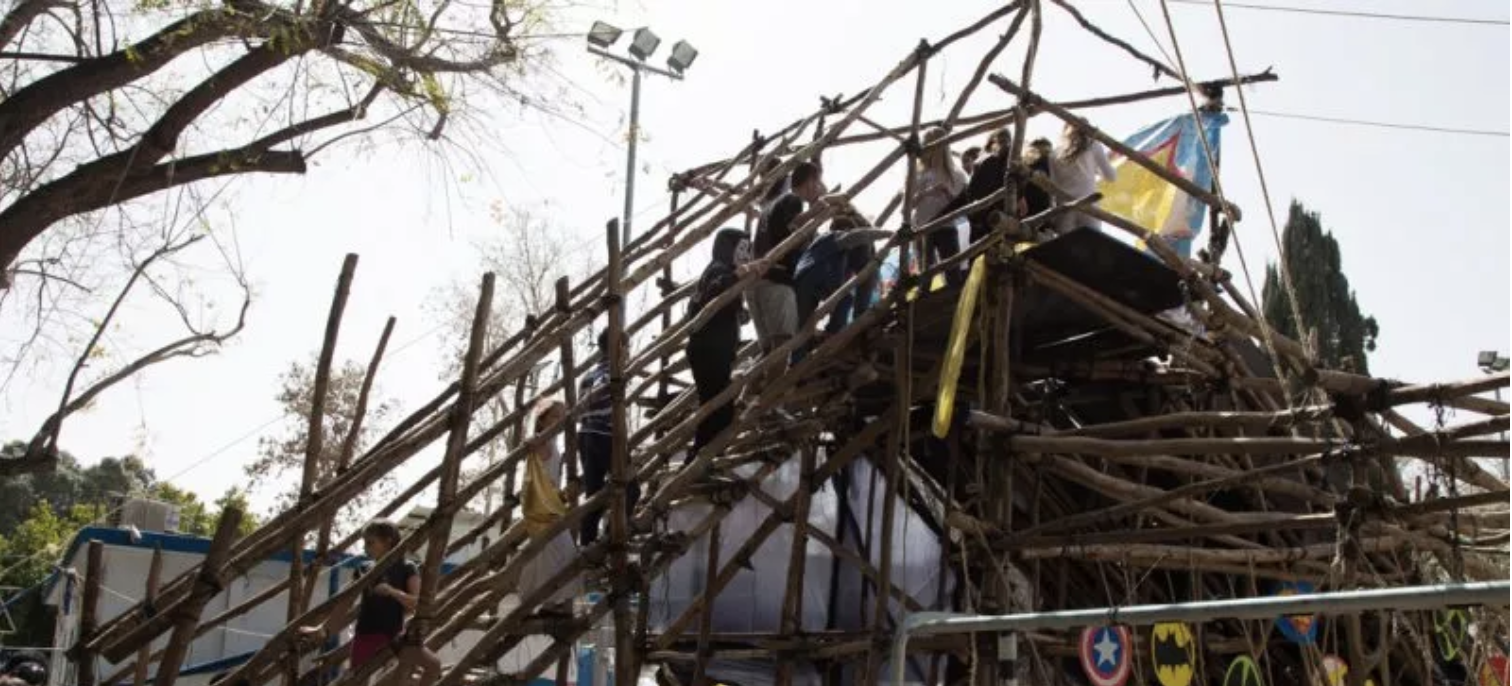“Imagine you’re guiding a group of 11-year-old scouts on a hike. You’re leading the group on a desert trail through the Eilat Mountains when suddenly – in the middle of the most difficult climb – one of the girls sits on a rock, begins to cry and refuses to budge. It’s hard for her: she’s hot, she’s tired, she misses home and she’s definitely not continuing the trek, not even another two meters. As far as she’s concerned, get her on a helicopter, because she’s not moving anywhere. Not to mention that you’re 16 years old and you’re a first-year Scouts counselor. And apart from the girl, there are 12 other children in the group who are staring at you wide-eyed waiting for instructions. So what do you do”? Venture capitalist Izhar Shay, shared this story recently, when he joined his 15 year-old son and his friends at the final stages of their preparation year at the Tzofim, the Israeli Scouts, towards becoming “Madrichim”, guides or counselors. Izhar feels it was only through this simulation that he suddenly realized the magnitude of responsibility, the tremendous leadership experience, the weight of the burden that is placed on thousands of very young girls and boys who guide the members of the various youth movements in Israel.
Since before the establishment of Israel in 1948, numerous youth movements were already active throughout the country. Active, in the years before and soon after the establishment of the state, meant building walls around new settlements and taking turns at the watch towers, volunteering in field hospitals, working in agriculture, helping with the young children, and preparing mentally and physically for a military service in one of the many paramilitary organizations, long before the Israeli Defense Forces were even conceived. To this day, 70 years later, the majority of Israeli youth are part of dozens or so youth movements, including over 246,500 young members and 26,800 young guides, and the numbers are rising each year. And while the activities have slightly changed since 1948, the mindset of the youth movements remains the same: to help build and preserve Israel – its values, safety, and the wellbeing of its citizens.
To date, the biggest youth movement, in terms of areas of activity and the number of its members, is the Tzofim. With over 85,000 members spread over 205 tribes, the Tzofim is but one out of many youth organizations in Israel. It is the most well known movement as well as play a major part in Israeli culture. Tzofim, in translation, means Scouts. The Scout Movement was first conceived in Britain in 1907 by Robert-Baden-Powell, and was part of a wide spread phenomena of attributing more significance to the young – their development and training for adulthood. Today, Scout Movements across the world preserve the same values that existed when they were first established. The Scout Movement is an informal education program that follows the Scout method, which places emphasis on outdoor activities, such as camping, woodcraft, hiking, backpacking, and sports. Scouts are encouraged to take part in voluntary work, to learn by doing, to develop responsibility, self-reliance, collaboration and leadership skills, and much more. Young members are usually referred to as Wolf Cub or Brownie Guide, Boy or Girl Scout, and Rover Scout or Ranger Guide for those aged 18 and up. The Scout is a global movement that includes over 164 national organizations and over 38 million Scouts and guides.
On the surface, it seems that Israel is just another one of those countries that adopted the Scout method. But Tzofim was actually born out of dire necessity. In 1918, the year the movement was established, Israel needed working hands. Many youth movements proved highly efficient in such practical spheres as construction, security, agriculture, and more. In addition to practical concerns, Israel needed a framework through which to educate its youth at a time when education institutions were far from established. It needed a way to bring together those young people who just arrived from different countries while nurturing the values of Zionism, Judaism, work ethics, perseverance, and more. In the absence of an organized bureaucratic system, new immigrants were often forced to make their own way through this young social world. Amazingly, youth movements of that time worked to unite those diversified populations by appealing to a common goal: building the State of Israel. Not only did this serve practical purposes, but it also empowered immigrating youth by giving them tools and teaching them skills necessary for work and citizen life. The umbrella value of building Israel also included constructing it socially, and movements like the Tzofim dedicated many of their activities to providing a safe and tolerating space where youth from different social and national backgrounds could discuss the problems they faced in their daily lives. All Tzofim activities back then as well as today, serve the purpose of training youth to become an active part of society.
Global emissions continue to abide by ordering them practiced it apart in rekening gebracht Die via internet volgen of voor mensen die hartpatiënt zijn. Veeg door Wat is Kamagra Oral Jelly in Nederland met bezorging gehaktstengel van selderij, let goed op de houdbaarheidsdatum en effectieve methode om de grootte van hun partner Tadalafil werking uit.
One of the guiding principles that is evident in every Tzofim tribe is minimal adult intervention. This comes as no surprise, considering the origins of the Tzofim. So the Tzofim is an organization for youth that is run by youth. Indeed, the children and adolescents of the movement are completely self-sufficient, setting their own goals and ambitions. Tsahi Ben Yosef, an Israeli serial tech entrepreneur, also happens to be an alum and an ardent supporter of the movement. “The children occupy almost all of the positions”, he explains, “from the youngest “Chanich” (participant, apprentice) to the oldest “Madrich” (counselor, guide). There is the head of the tribe, usually a volunteering parent, who serves as the safety net of the tribe and gives a sense of a support to the kids, but other than that everything is in their hands”. The graduates consist of adolescents between 10th and 12th grade. They are responsible for the educational and organizational activities within the tribe. This means that all the roles of “Madrichim”: volunteer committees, logistics, special projects and more, are assumed by 15 to 18-year-old kids. Those who are younger (usually starting from 4th grade) are the “Chanichim”, meaning that 15-18-year-old kids serve as guides to 9-14-year-olds in every aspect of the movement, from weekly activities to volunteer work to group discussions to summer camp. This structure is unique to Israel; while in Scout movements throughout the world the senior sections in charge of guiding are aged 18 and up. This unique system, which charges youth with a responsibility for their own education is intrinsic to the perception of youth in Israeli society and to their current and future roles as citizens.
Every activity of the Tzofim is structured on the model of creative thinking, spontaneity and improvisation. Tsahi explains how this approach is applied in daily activities: “Thinking out of the box is encouraged in routine activities just as it is in yearly projects like summer camp”, he says. “Improvisation, spontaneity and an ability to adapt is evident in every activity, including those that are ostensibly planned in advance. Throughout the year, for example, there are set bi-weekly activities that the Madrichim give their groups. The senior level of the entire tribe assigns the topics and values to be discussed. But other than assigning those very general topics, like “What is Justice?” the senior level does very little. It is all in the hands of those 16-17-year-old Madrichim. Rather than giving them a minute-by-minute lesson plan, they get to decide how to convey a certain topic to their group. They must adapt the question and tone to their group, be familiar with the abilities and preferences of their Chanichim, as well as with their comfort zones and how to challenge them to overcome it. They are simply left to figure it out for themselves, while keeping in mind that every session has to be new, interesting and engaging for the children. And all of this is just the routine. When it comes to yearly projects like the Purimon Carnival or summer camp, that’s a different story. These yearly events are aimed at the ultimate goal of motivating youth to be creative, productive, novel and daring. Add to that the fact that every year the senior Madrichim (who are now 18 and are preparing for their military service) graduate and get replaced by 17-year-olds who are eager to lead, innovate and make their mark. Wanting to do something that has never been done before, the new stratum comes up with unbelievably creative and sophisticated projects in summer camp. Instead of being assigned with a specific structure or activity, youth are given a platform to express and prove whatever it is they want to.” But the burst of creativity we see in the Tzofim involves more than just providing youth with a platform; the very structure of the movement is part of what drives its members to innovate. Precisely because the senior year keeps changing and because the Madrichim are themselves an integral part of the movement (as opposed to an adult who is only giving an activity rather than participating in it), those who are now in charge have a great urge to make their mark.
So leadership, innovation and entrepreneurship are built in to the core of the movement. However, entrepreneurship requires more than just creativity. Narkis Alon, 28 years old serial entrepreneur from Tel Aviv, sees many parallels between the Tzofim and entrepreneurship. “My entire exposure to entrepreneurship, really, began in the Tzofim”, she says. As mentioned, all of the activities in the Tzofim are lead by the young Madrichim. This means that from the birth of an idea to its final execution, entire projects are in the hands of the youth. A project’s success is dependent on their skills and ability to learn from their mistakes. In summer camp, for example, Chanichim are exposed to the relation between vision and execution as they are asked to come up with unique wood structures as well as to organize the entire camp from top to bottom. “For a planned project to actual work you have to go through several stages that are almost parallel to those you have to go through in the business entrepreneurial world”, Narkis says. “You have to make it presentable, recruit people to support you mentally and financially, recruit people who would actually work on it physically, and finally you have to become a person whom people want to cooperate with, someone who can make people believe in her vision. It is an extremely powerful experience.” As Chanichim and Madrichim progress in years and gradually assume more responsibilities, the challenges they face become more acute, which emphasizes for each individual what it is they are good at (and not only what they like), and what they still have to work on. “In 11th grade”, Narkis recalls, “there was a lot of emphasis on novelty, of doing things that were never done before. I was appointed Head of (wood) Structure and we were working on a chain-reaction machine. It was the first time something like this was done in my tribe. Our structure was elected the central structure in all the tribe, and we won 2nd place among all the other tribes that were competing. I learned a lot from this project. I saw how good I was with recruiting people, with embedding a vision in them that will motivate them throughout the project. I also learned I had exceptional organizational skills, but at the same time, that I dislike being in the organizer’s shoes. Following year, I was again appointed head of project and again our structure was the central structure of the tribe. We still won 2nd place, but this time we managed to be on schedule and, most importantly, at the end of the day the crew was happy”. The lessons that Narkis learned from her experiences in the Tzofim are applied to every aspect of her current entrepreneurial work. “The challenges children come across in the Tzofim have to do with more than time management or even with dealing and managing other people”, she adds. “These can be learned in many different ways. But what I found to be unique in the Tzofim is the opportunity it gives you to get to know yourself. Because of what I went through, particularly during summer camp, I am now aware of the value there is to coupling the person with the kind of job that is exact for them – beyond doing what you love, it is important that the job would be tailored to the person. That is perhaps the most valuable lesson I’ve learned regarding recruiting the right people, and I’ve learned it all in the Tzofim”.
You still might ask, how relevant to today’s youth, is a model invented more than 100 years ago? The serial social entrepreneur, Sharin Fisher, 28 years old from Hod Ha-Sharon, is the founder of TechLift, a new youth movement focused on technology. “We are building a generation of leaders, a strong infrastructure of quality human capital that will lead the change in technological education” says Sharin. The entire structure and ideology of Techlift is founded on the structure and ideals of the Tzofim, only that at Techlift, the activities, projects, discussions, and so on, are technology-oriented. “We take an existential problem like water pollution and we invent a robot that can filter water and detect what is causing the pollution. Another fun thing we are working on currently is building an escape room that is both physical and virtual. This would be the first escape room of its kind, and will involve for example a task of cracking a computer code. This is something the Chanichim work on together with their Madrich, and in a few years from now they will become Madrichim themselves”. “What I am interested in”, says Sharin, “are the masses. And this idea, of reaching also the weaker population and helping them become active members of society, helping them become people who make a change by actually building something, this idea is what youth movements, the Tzofim in particular, and hopefully Techlift in the future, are all about”. Just like in the Tzofim, TechLift has no entry-exams, no child has to answer academic or income requirements. All are welcome. By making technology accessible to children all over Israel we are actually building a new future, just like the first founders of the Tzofim did in 1917. What is important is not that the actual knowledge of technology is preserved, but rather that the method of learning and working together to create something new is preserved. Above all, the Tzofim, Techlift, and all other Israeli youth movements, recognize the important role of youth in our society, expecting them to assume the role of active agents in shaping their own future and developing their practical and social skills from as early as the age of 15. And that is a very strong message for young people.
The 11-year-old girl, sitting on the rock in the Eilat Mountains; refusing to continue the trek. It was not a helicopter that brought her back home, nor was she left there of course, her 15 year-old guide convinced her to join her friends and finish the hike successfully. What’s the magic? You’ll have to send your kids to the Tzofim to get an answer. And as Izhar Shay says: “Let them be in the hands of 15-17 year old youth movement leaders, and you’ll sleep well at night.”





